Growlers of Indian Air Force
By: Rishav
BLOGS
Being fourth largest in the world and the strongest in South Asia, Indian Air Arm is counted as one of the most influential airpower on the globe. Sharing borders with an arch foe (Pakistan), and a potential foe (China), it is a necessity for the state's armed forces to stay alert and maintain operational preparedness throughout the year. With 600+ fighter jets in the inventory, Indian Air Force owns a good fleet of combat capable advanced fighter aircraft, and very recently, it acquired the highly famed Dassault Rafale, a French origin modern fighter aircraft classified under the 4.5 generation category and technology unmatched in the region. The Dassault Rafale is considered as a top-notch aircraft with successful mission experience against targets in Syria and Libya. Talking about experience, there is no doubt that the Indian Air Force is also one of the most experienced Air Forces in the world, showing its potential in 1965, 1971, 1999 and 2019. And it was every time against western neighbor and the arch rival we were talking about, Pakistan. "Who won the air warfare" is still a hot topic of debate. Skilled pilots of both nations went head-to-head against each other, with each side not just carried some of the most delicate weapnary during the operation, but also came up with their own theories in the aftermath. However, we are not going to enter this deep field today.
Our point of interest in this article is the Electronic warfare (EW) capability of Indian Air Force with offensive package, and especially with airborne combat jet platforms which remain a frontline attack platform throughout the whole year but multiplies it's capability with addition of new hardware. In simpler words, we are going to talk about fighter jets of the Indian Air Force which can perform effective electronic warfare as their secondary role. Fact is that the Indian Air Force doesn't operate a dedicated EW combat aircraft like the E/A-18 Growler of US Navy, it has to rely on jammer equipped fighters. It must be noted however, that among the hundreds of subjects kept under the "classified" tag within armed forces, Electronic Warfare is also one of the issues that is not discussed thoroughly in public. However, we managed to get some authentic inputs from authentic sources.
Network Centric Warfare
Network Centric Warfare is today a core component for maintaining battle preparedness along with effective coordination in real time. NCW generally means to have an uninterrupted link with all the elements on and off the battlefield, both via datalink and communication systems, that allows precise mission handling and decision making after analysing threat scenarios. Regardless of being such a critical element, the system is also vulnerable to hostile offensive attempts and needs to be protected wisely. NCW can be disrupted, adversely affecting operational precision and deteriorating the quality of coordination. Hence, it needs to be prepared for every attack, either in the form of electronic or physical.
The NCW competence of the Indian armed forces is still unmatured, for the reason that it still lacks proper connectivity between platforms. While the overall application is limited, the necessity to establish a highly co-operative and co-ordinative battle management system is duly realised and the pace to match the modern warfare requirements is in pipeline.
Threat Library
Ever wondered how an EW system chooses a response against the identified threat. It's the "threat library" from which the best response is picked autonomously. Threat library is generally a database stored in the microprocessor of the system, containing information regarding the adversary's battle systems and order of engagement. For example, a Radar Warning Receiver (RWR) can provide early warning about radar threats only when it acknowledges the frequency and type of radar, so that the operator onboard can precisely understand and push required countermeasures. All such information is collected by ELINT/SIGINT platforms and other measures and goes through regular updates.
Bandwidths
Understanding bandwidths as an aspect of EW is an equally important deal. Bandwidth in the military generally describes the multiple types of frequency ranges and wavelengths classified under the radio frequency spectrum. Radio Frequency based equipment operate within a dedicated bandwidth. The common bandwidths are:
L-band: 1 to 2 GHz
(Application: Long range surveillance radars)
S-band: 2 to 5 GHz
(Eg: Short-to-medium range surveillance radars)
C-band: 5-8 GHz
(Application: Mobile short-to-medium range radars)
X-band: 8 and 12 GHz
(Application: airborne radars and short range radars)
Ku-band: 12 to 18 GHz
(Application: Radar guided (RF) missiles)
With all such basics cleared, it's time to jump straight into the topic we introduced in the title.
History: Sqn 35, IAF "Wild Weasel"
The origins of the dedicated EW role can be traced from the history of No 35 "Rapiers" squadron. Raised in 1958 and originally as bomber squadron with a fleet of English Electric Canberra B(I).58 bombers, the squadron switched to a dedicated Electronic Warfare squadron in 1978 with introduction of MiG-21Ms while Canberras remained in service with the wing, albeit now modified for commencing EW role. The first Airborne Self Protection Jammer to be pitched into action was called "Chatterbox", a Swedish origin sound jammer that was capable to blind the air defence radars at short range and provide electronic protection to a formation.

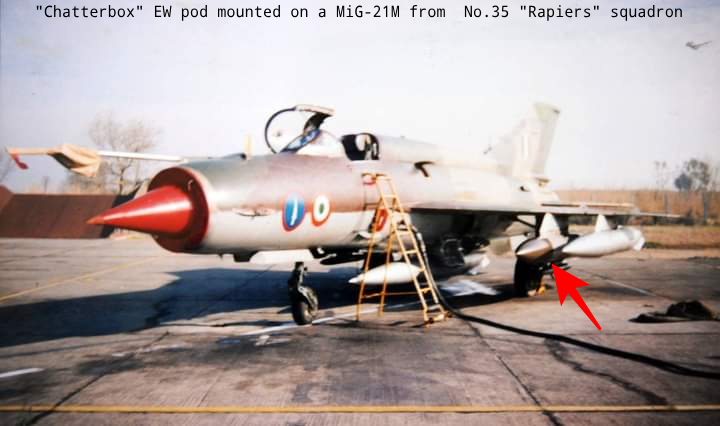
Today, the squadron operates state-of-the-art Sukhoi Su-30MKI heavyweight twin engine air superiority aircraft, that can be fitted with generation ahead EW solutions and undoubtedly a highly prestigious role player in enhancing air combat effectiveness in modern warfare scenarios. However, it is pretty understandable that with evolution of new technologies and now with every modern fighter aircraft compatible to carry its own Electronic Counter Measure solutions in much miniaturized sets instead of heavy weight canisters, complete dependency on one squadron is no more a case.
Mikoyan Gurevich MiG-29UPG
"Fulcrum '' for the rest, while "Baaz" for India, the MiG-29 is a highly underrated platform of the Indian Air Force as it remains out of media limelight. Inducted in 1985 as MiG-29B, the air defence fighter from Soviet Union was a direct counterpart of General Dynamics (now under Lockheed Martin) F-16 "Fighting Falcon" that was acquired by Pakistan Air Force in the same time period. With medium range missiles like R-27R and Shchel-3UM Helmet Mounted Sight (HMS) system cued with Close Combat Missiles, the Baaz did not take much time to prove its "edge" over the airpower in West, that is Pakistan in Indian subcontinent.
The latest version in service today outmatches even the Russian counterpart. MiG-29UPGraded, while primarily an air defence fighter with modern era offensive and defensive package designed to deal with adversaries' top notch battle systems in all weather conditions, it's integrated Electronic Warfare suite is one of the salient features of the upgrade package, that is sufficient to match the contemporary battle requirements
D-29
D-29 is an integrated EW suite of MiG-29 and first of its kind active with the Indian Air Force, i.e. featuring an embedded directional jammer system. Developed by DRDO Defence Avionics Research Establishment (DARE) labs, D-29 is also an example of hybrid Indian experiments that involves integration of equipment of multiple origins on the same platform. The DRDO D-29 EW includes a combination of RWR, Electronic Counter Measures (ECM) and Electronic Support Measures (ESM) components designed to identify and neutralize threats in flight. The indigenous Tarang Mk II Radar Warning Receiver (RWR) is employed to track sources of Radio Frequency (RF) illumination to offer situational awareness to the pilot. The integrated Digital Radio Frequency Memory (DRFM) based Italian Elettronica ELT-568 Self Protection Jammer (SPJ) allows jamming of Ku-band seeker of incoming radar guided missiles and S-band radars, safeguarding the aircraft in combat missions.
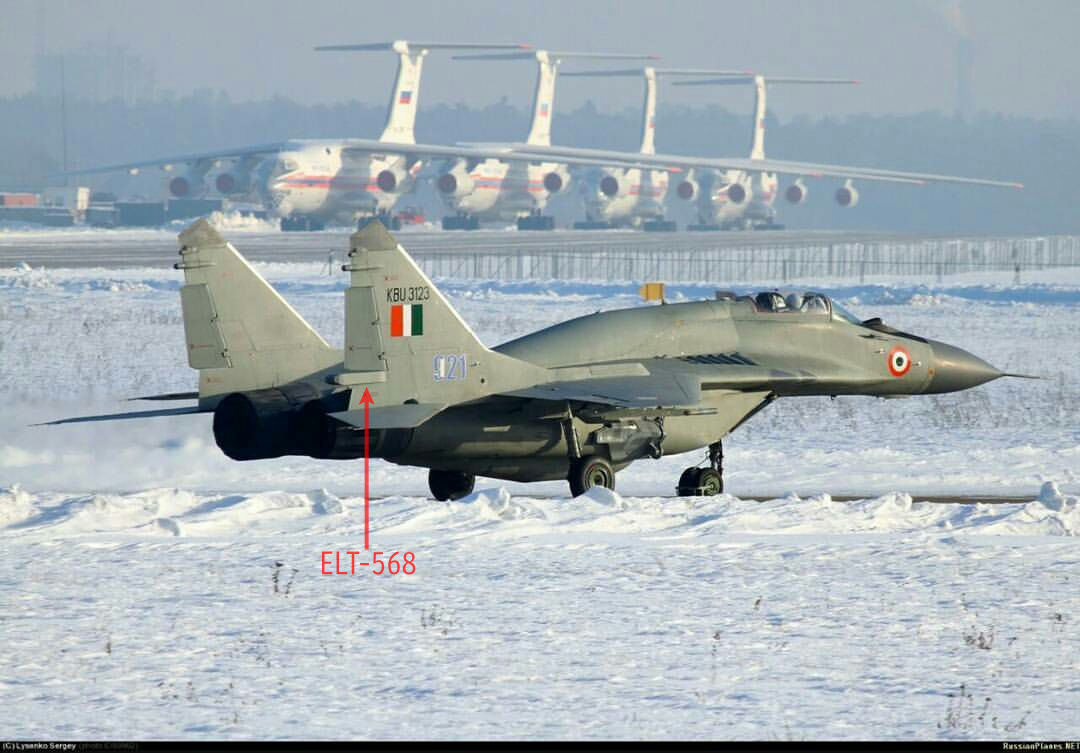

The jammer works on cross eye jamming principle. Cross-eye jamming is an electronic attack technique that induces an angular error in the radar by artificially creating a false target and deceiving the radar into detecting and tracking it. The system mainly consists of Unified Receiver Exciter Processor (UREP modified to suit the requirements of D-29), Solid State Transmit / Receive Unit (SSTRU) with Active Array Unit (AAU) and a liquid cooling system. Presently, there is no effective anti-jamming method to counteract cross-eye jamming.
Sukhoi/HAL Su-30MKI
Dubbed as the first line of defence, Su-30MKI is the most abundantly available fighter aircraft in the Indian Air Force. Inducted in 2004, the Indian customized Su-30MKI is an air superiority fighter with 250+ units in service. The aircraft is also suitable for precise Strike missions, as the twin seat configuration allows the Weapon Systems Officer (WSO) to manage the air-to-ground munitions more comfortably. The aircraft features a long range Phased Electronically Scanned Array (PESA) radar. Alongside radar, it features technological advancements over the basic Su-30 and Su-27. Twin AL-31F turbofan engine Thrust Vector Control (TVC) supported nozzles makes it a highly maneuverable beast.
The air-to-air weapon package is also very suitable for its field of combat operations. Newly inducted Astra, alongside RVV-AE/SD and R-27R/ER/AE provides good combat capability in Beyond Visual Range (BVR). The aircraft's Electronic Warfare suite is flexible with provisional addition of hardware on external hardpoints. Here, we look at the airborne jamming pods available with Su-30MKI:
SAP-518
Developed by Russia based Kaluga Scientific-Research Institute for Radio Engineering, or KNIRTI in it's native acronym, SAP-518 is a latest addition in the jammer pod family produced by the company since late 70s. It is a high band self protection jammer that is mounted on the wingtip hardpoint of the aircraft and counters the threats like radar systems and incoming missiles operating under 5-18 GHz bandwidth (X and Ku-band). The DRFM based jamming method employed by the systems offers significant protection to the aircraft or a 2 ship formation.
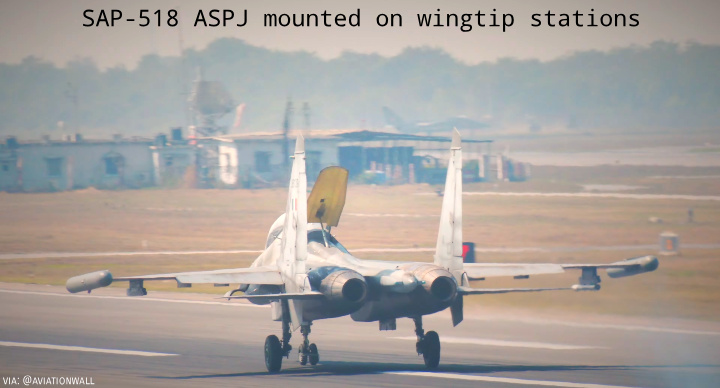

SAP-14
An Electronic Attack Pod (EAP) or a Low Band Jammer, SAP-14 is designed by same KNIRTI to counter major ground based systems like air defence radars, operating within 1-5 GHz bandwidth (L and S band). It is highly recommended during strike missions as it provides protection to friendly units flying in hostile airspace. It is also called an escort jammer as it can be used while escorting strike fighters and avail them safe passage by jamming the adversary's air defence systems.
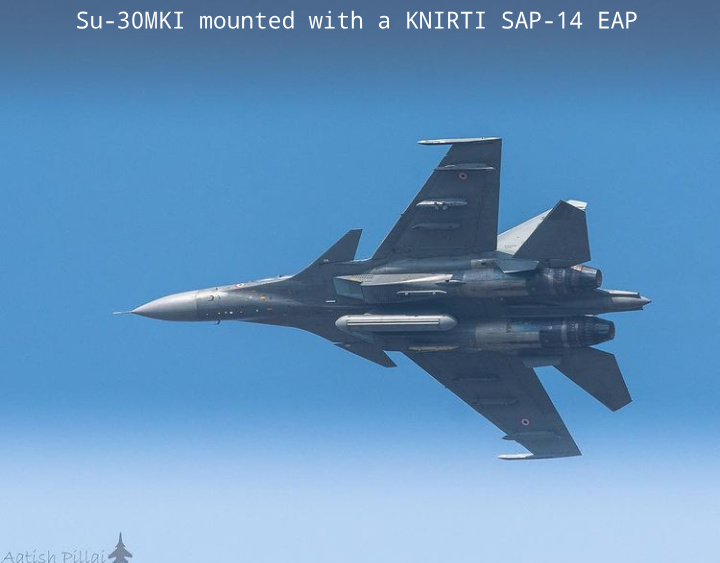

"Growler" combination
The combination of SAP-14 and SAP-518 on a single aircraft can actually make it an effective EW platform for Suppression of Enemy Air Defences (SEAD) missions, as it covers both airborne and ground based threats operating within L, S, X and Ku bandwidth, two at a particular time. Su-30MKI equipped with this combination can protect a whole strike formation during a variety of missions. The Russian Federation air missions over Syria often operate Su-34 with this configuration to prevent any . It is believed that one or more such kinds of Su-30MKI also took part in Indian Air Force Operation "Bandar" 2019, and played the role of an escort for the strike package of Mirage 2000 aircrafts. And according to the Indian Air Force, the mission went "unchallenged", hinting that the friendly aircrafts probably didn't face any hostility during their entry to and exit from Pakistan airspace.
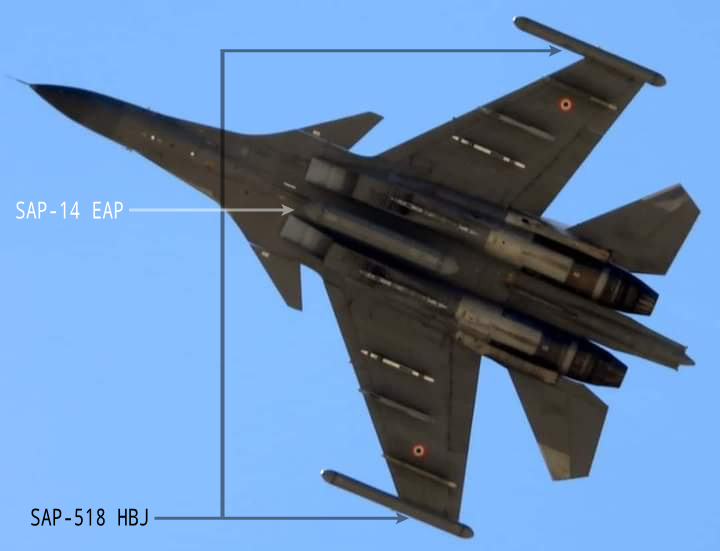

Dassault Rafale F3R(I)
Rafale, not just the latest for the Indian Air Force but also for the whole subcontinent. The French made aircraft is a highly potent system capable enough to conduct omnirole operation in a single mission and with top-notch precision in all-weather conditions and an electronically hostile environment. Being a highly expensive fighter plane, Rafale clearly offers more than what is already available in the fleet. From effectual air superiority with short-to-long range air-to-air missiles to strike provision from standoff distance with state-of-the-art cruise missiles and precision guided munitions, the battle machine is undoubtedly an asset with quality and capability to manifest the airpower dominance in the region. However, one of the flagship comes embedded with Rafale is it's SPECTRA suite, that provides full-fledged protection package, along with top-notch electronic strike ability to the platform. Here, we discuss all-the publicly known features availed by Rafale and it's EW suite:
1. Sensor Fusion
It is one of the core elements of Network Centric Warfare as it drastically enhances the combat potential of the system. It allows the operator to receive inputs from third party sources like an AEW&C aircraft, ground based installations, etc., and combine them together to attain high capacity situational awareness and increased combat range. With long range Airborne Early Warning radars providing air situation from standoff distance, the aircraft can perform missions or add necessary changes into the mission in-flight as per the threat scenario.
MBDA Meteor, a Ramjet powered active radar homing air-to-air missile designed to take down airborne bandits at long ranges, sports dual way guidance ability and hence, a Rafale need not to be in hostile airspace for long as the missile, when launched, can guide itself to the target (if seeker tracks the target within range) or recieve terminal guidance from an AEW&C nearby via datalink.
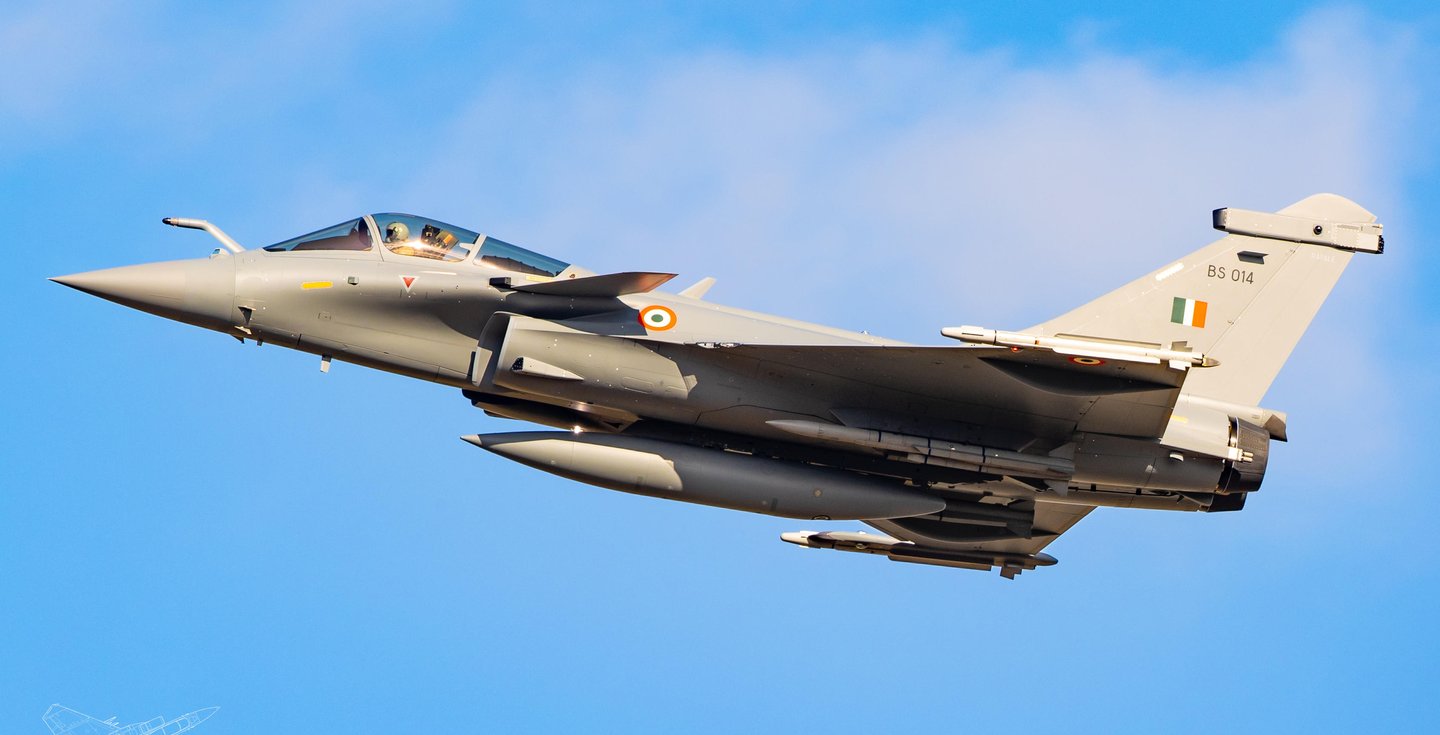

2. Active Radar Cancellation
One of the proven features, Active Radar Cancellation (ARC), when cued with the aircraft's already low Radar Cross Section (RCS), gives a Observable (LO) or "stealth" profile during missions, a capability that is in practice without officially classifying it into a 5th generation jet fighter. As the name suggests, ARC focuses on "cancelling" the hostile radar waves return and preventing detection of the aircraft. The action involves sampling and analysing incoming enemy radar waves and feeding it back to the hostile emitter “out of phase” thus cancelling out the returning radar echo.
Dassault Mirage 2000
Being the last member of the highly famed Mirage family from Dassault Aviation, the Mirage 2000 surely stands at the top while continuing the legacy of formidable delta wing fighters with devastating firepower potential. The Mirage 2000 was introduced in Indian service in 1985 and it didn't take long for the organization to pitch the system on combat sorties. However, the first major scale air missions were carried out during the Kargil skirmish of 1999, under operation "Safed Sagar". Dropping a diverse range to offensive air-to-ground munitions, ranging from bulks of 250lb dumb bombs to multiple 1000lb Paveway Laser Guided Bombs (LGBs), the Mirage 2000 "Vajra" effect was very much visible in the visuals recorded by targetting pods.
The $2.1 billion contract signed in 2011 to carry out Mid Life Upgradation (MLU) of the aircraft reflected Indian Air Force's keen interest and trust in wielding the platform for further long run. The newly designated Mirage 2000"I", based on the original Mirage 2000-5 (DASH 5) Mk2 package, covers modernizations on both offensive and defensive systems, enhancing the potential of the aircraft and standing up against the adversary's attempts to gain tactical gambits. It's ECM systems also witnessed great boost
ICMS
The Integrated Counter Measures System (ICMS) Mk4, two generations ahead of ICMS Mk2 fitted on early Mirages, provides next generation protection and early warning to the aircraft against hostile IR, RF and electronic threats. The whole composition incorporates three Radar Warning Receivers (RWR), two way detector-jammers on the tail and a chaff/IR flare dispenser on the belly. Replacing old ABD-2000, which utilised obsolete sound jamming tactic for RF emitters working under 6 to 20 GHz, the new airborne self protection jammer is now more capable to neutralize incoming threats while in-mission.
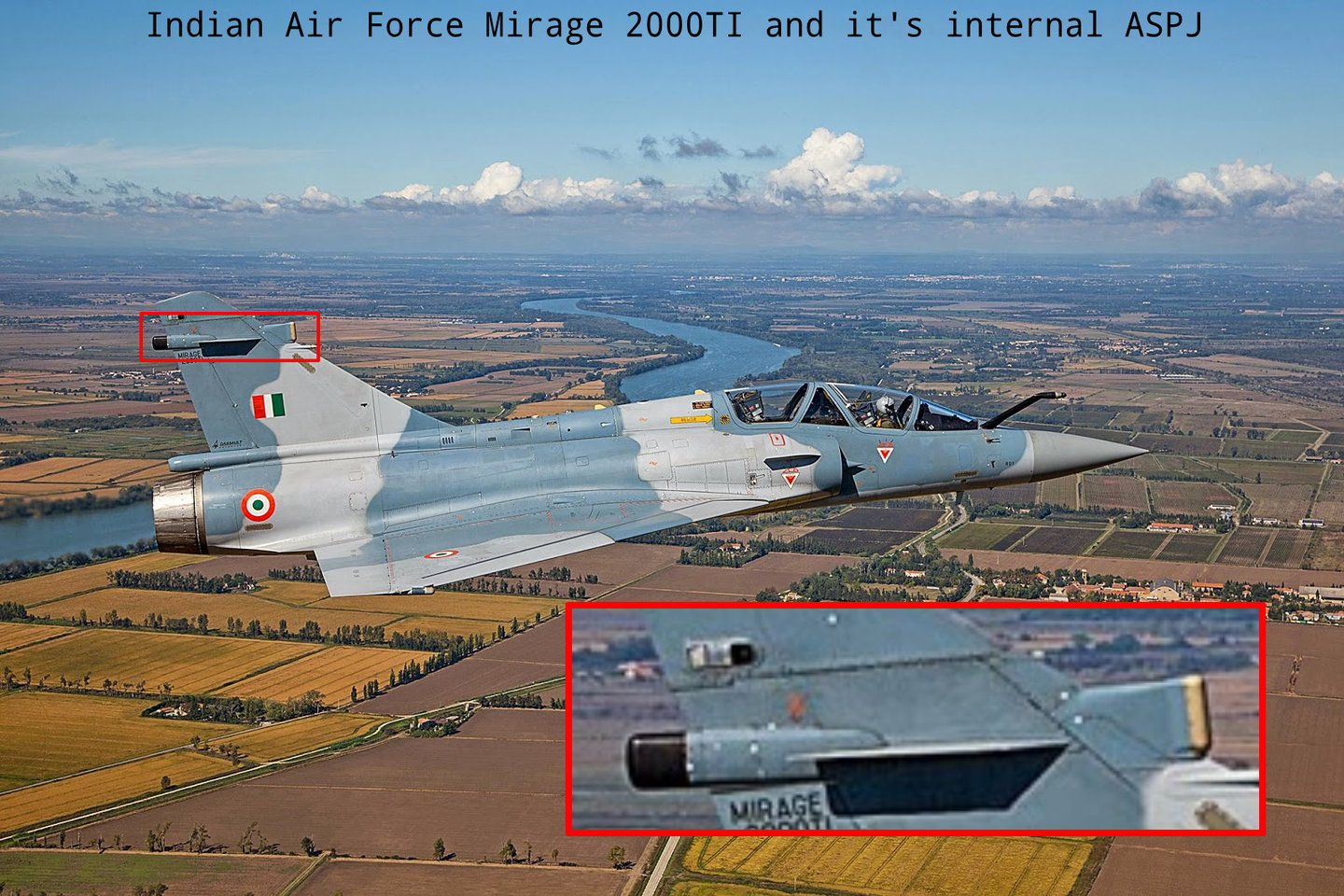

Caiman
An escort low band jammer, similar to SAP-14, in service with the fleet. It's existence is still secretive as no photos are released in public. However, it is already confirmed by multiple sources that Caiman is in active service since a pretty long time. It employs mediocre barrage jamming tactics against air defence radars operating within L and S bands. The system was carried by Indian Air Force Mirage 2000 during strike missions over the height of Kargil.
Remora
Another pod in last leg of service due to obsolete technology. The Remora dual band SPJ offers protection of the platform against X band and Ku-band systems while using sound jamming. At present, Remora is only active with remaining "H" standard units that are yet to be fitted with new ICMS. These old pods supporting barrage and sound jamming are now ineffective for combat as modern missile and radar systems are capable of detect disruption in their operation. Latest generation air-to-air Missiles like AIM-120 or PL-15 are embedded with Home On Jamming (HOJ) mode that tracks the jamming source and target the specific system invoved in attempt to neutralize the projectile's guidance. Therefore, deploying them for combat today may leads to additional unexpected losses.
ELL-8222: India's one way solution to contemporary electronic problems
EL-8222, a premium product from Israeli firm Elta, can be termed as Indian Air wing's "standard issue" element as it not just in service since past multiple years but also applied on multiple platforms in service with the Indian Air Force and Indian Navy. Sukhoi Su-30K (and successor Su-30MKI for the first few years), MiG-21Bis UPG "Bison" and even MiG-27 "Bahadur" (now phased out) had the system as primary airborne self protection jammer while MiG-29K of Indian Naval Air Arm is the Israeli pod as primary Self Protection Jammer. India's indigenous light combat aircraft Tejas and it's future variants are also expected sport the system to deal with major electronic threats during air combat missions.
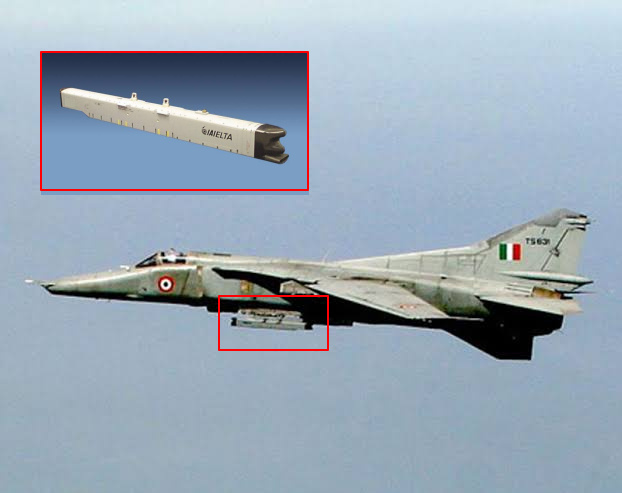

This wide band jammer is estimated to cover the bandwidth 2-21 GHz while utilising DRFM deception jamming tactics in operation. The jammers served in some spectacular missions, some remarkable ones were noted in joint air combat training with foreign forces, specially United States Air Force who were in dilemma after watching Bisons in their tail, which were equipped with Elta pods and kept their radars and hence, no warning was tipped to Eagle pilots. Overall, the ELL-8222 offers complete flexibility in terms of installing it on various platforms in service with the organization.
Local and secure alternatives
EW systems are somewhat a delicate piece of a country's technological marvels and hence, remain under closed doors when it comes to disclosing their complete statistics. Having an indigenous solution in this field offers more independent operationalization and flexibility of the system. The Defence Avionics Research Establishment (DARE) wing under state-owned Defence Research and Development Organization (DRDO) is a premium and dedicated facility to design, develop and test modern electronic warfare systems. With wide range if products successfully manufactured and delivered to user, including radar warning receivers, software systems, full package EW suite and many similar Electronic CounterMeasures (ECM) elements, it is the most promising complex to fulfill jammer requirements in India.
A High Band Jammer (HBJ) is reportedly in works that will eventually replace the imported systems active with the fleet. The indigenous system will cover wide bandwidth and use DRFM based deception. The system will also be compatible with other sub-systems of the aircraft unlike the previous cases where here were issues faced while attempting to interface Russian jammers with Indian components onboard the aircraft, one of the cases of which was with Su-30MKI, where glitches and errors were faced while interfacing the Russian jammers (SAP-518/14) with Indian RWR (Tarang) or Israeli jammer (ELL-8222) with Russian radar (N011M BARS PESAR).
Another remarkable system in active development is pod based Dual Color Missile Approach Warning System (DC-MAWS) that is reportedly in final phase of trials. The system will enable the aircraft to receive precise early waning against multiple types of conventional missiles, RF, IR and more. Except Rafale, every IAF aircraft lacks such equipment and pod based provision is seen as a necessary solution to maintain modern battle standards.
In conclusion, Electronic Warfare via Indian suppliers is in full swing and at a stage where New Delhi is self-sufficient to produce and pitch them in actual combat missions. On February 27 2019, it was Tarang Radar Warning Receiver fitted on Su-30MKI's tail that detected the AIM-120 Advanced Medium Range Air-to-Air Missile (AMRAAMs) fired by Pakistan Air Force.
Deemed as a highly reputed and professional force, the Indian military has very well understood the significance of modern battle systems and their future potential. The effort to develop technologies in-house is widely implemented and in practice. With adoption of indigenous solutions for major tasks and substituting foreign expensive material with locally developed alternatives, the Indian defence industry will grow a lot with an aim to attain a renowned rank in global market. The subject of Electronic Warfare, though not presented exhaustively in Indian context, acts as a significant unit for carrying battle planning, management, action and final execution.
